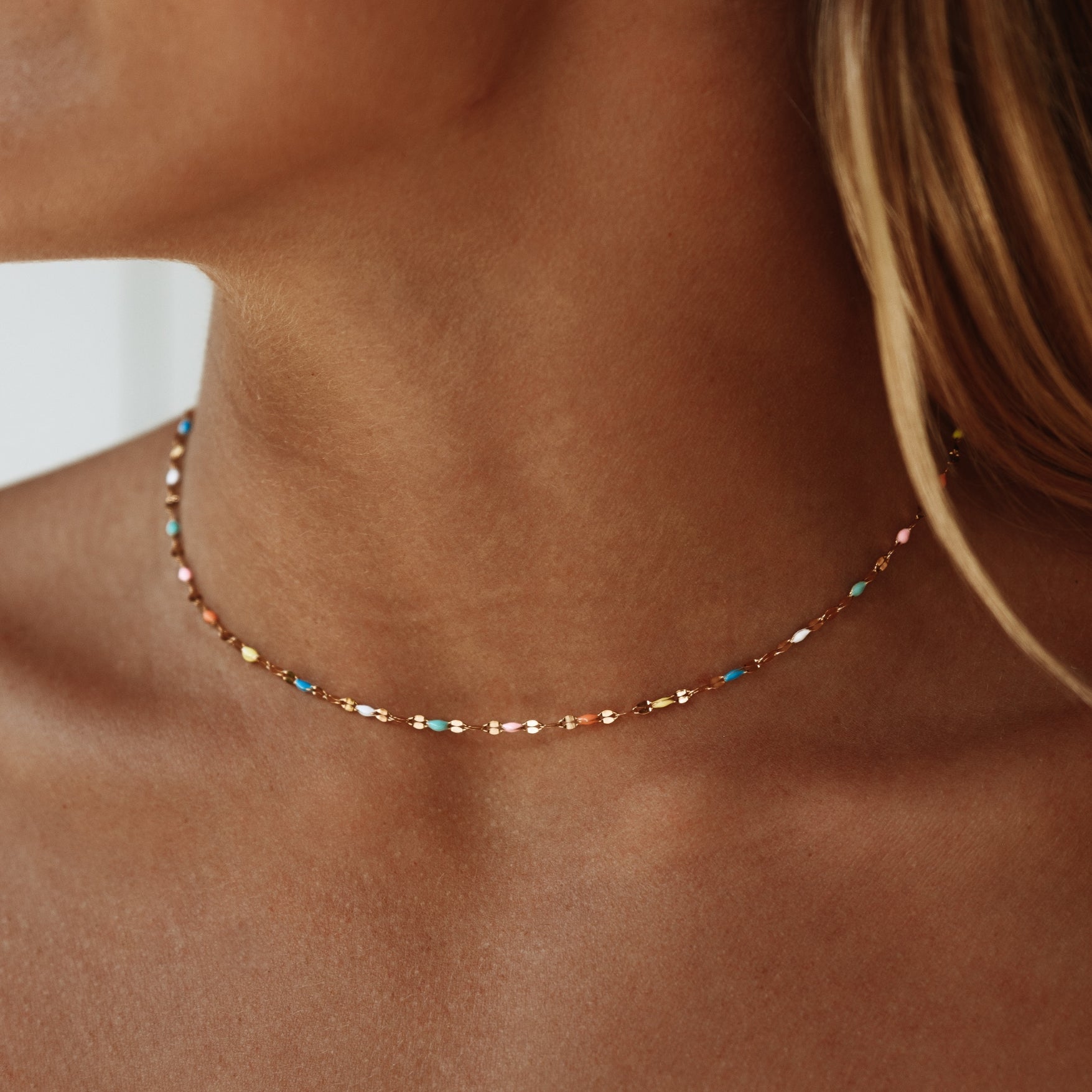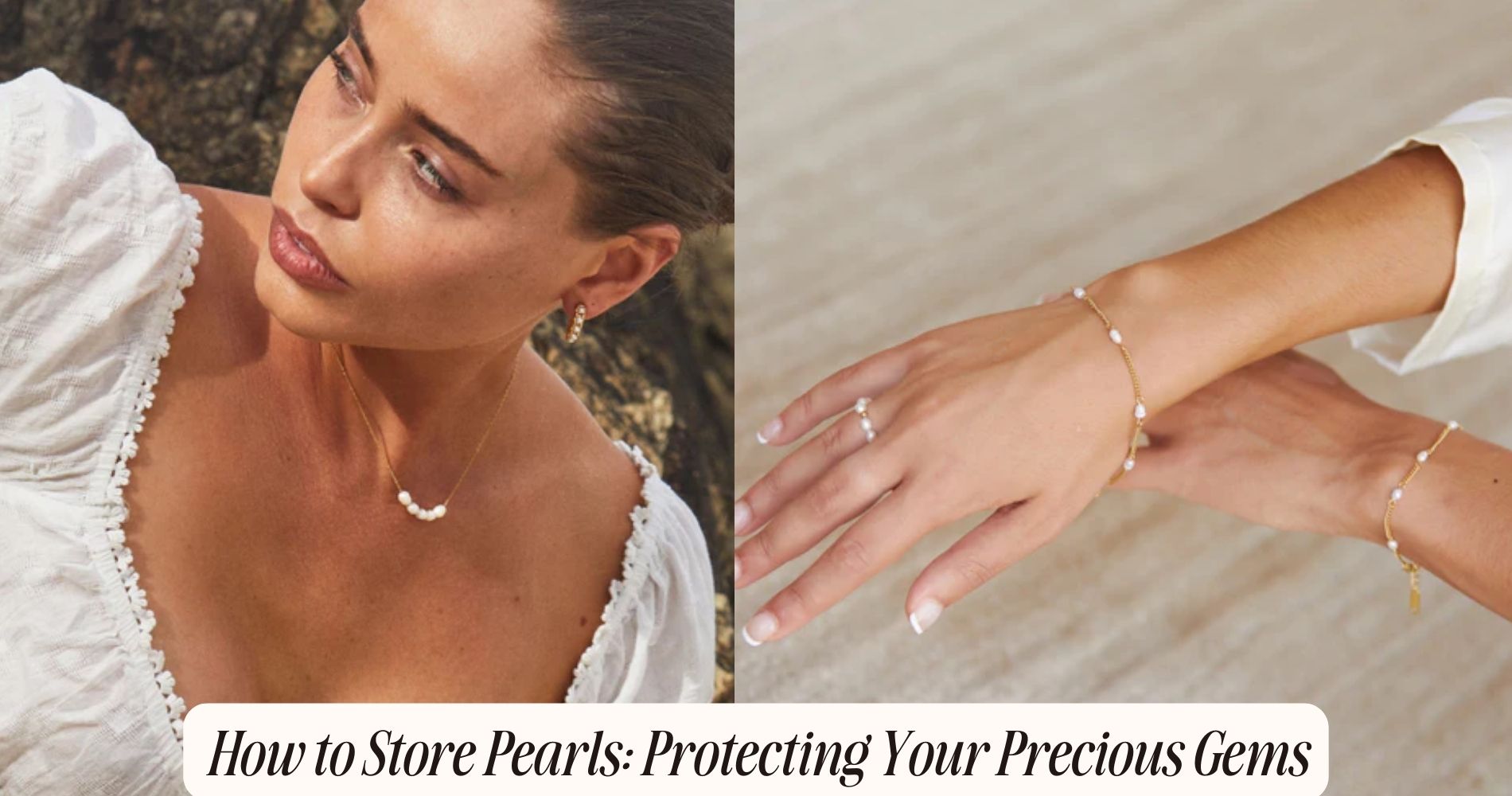
Does a Stainless Steel Necklace Rust? Durability Explored
Does stainless steel necklace rust? A stainless steel necklace generally doesn't rust thanks to its chromium content, which creates a protective layer against corrosion. This durability makes stainless steel a favored choice for jewelry, as it's less prone to tarnishing compared to silver and requires minimal maintenance. However, environmental factors like humidity and exposure to harsh chemicals can impact its longevity. While stainless steel is largely resistant to wear and tear, it's important to care for it properly. Regular cleaning and smart storage can extend its life considerably. Discovering more about the specific grades and care tips can help maximize your necklace's durability in our Waterproof Necklaces collection.
Understanding Stainless Steel Composition
To fully appreciate the durability of stainless steel necklaces, it's essential to understand the specific alloy composition that gives this material its unique properties.
Stainless steel isn't a single metal but rather a family of alloys, categorized into various stainless steel grades. These grades, such as 304 and 316, differ markedly in their composition and, consequently, their performance.
When you examine alloy variations, you'll note that elements like chromium, nickel, and molybdenum play pivotal roles in enhancing corrosion resistance and strength.
For instance, the presence of at least 10.5% chromium provides a protective layer that prevents rust, while increased nickel content contributes to improved ductility and formability.
Similarly, molybdenum inclusion enhances resistance against pitting, particularly in marine environments.
Properties of Stainless Steel
When you consider stainless steel for your necklace, it's important to understand its composition and the various alloys that enhance its properties
Corrosion resistance is a critical factor that determines the longevity of your jewelry, and knowing how to maintain it will keep it looking new.
Composition and Alloys
Stainless steel's unique properties stem from its specific composition of iron, chromium, and other alloying elements, which work together to enhance its strength and corrosion resistance.
The primary component, chromium, is typically present in a minimum of 10.5% concentration, forming a passive layer that protects the metal beneath. Depending on the stainless steel types, additional elements like nickel, molybdenum, and titanium can be incorporated, each contributing to different characteristics.
For instance, austenitic stainless steels, which include grades like 304 and 316, are known for their excellent formability and resistance to oxidation, making them ideal for various alloy applications, such as kitchenware and medical instruments.
On the other hand, ferritic stainless steels, with lower nickel content, offer better resistance to stress corrosion cracking and are often used in automotive applications.
Corrosion Resistance Factors
Corrosion resistance in stainless steel relies heavily on its chromium content, which forms a protective oxide layer that prevents rust and degradation from environmental factors. This layer is vital because it effectively blocks moisture, oxygen, and other corrosive agents from penetrating the surface.
Different corrosion types can affect stainless steel, including pitting, crevice corrosion, and stress corrosion cracking. Each type arises due to specific environmental factors, such as chloride exposure or high humidity.
When you wear a stainless steel necklace, you benefit from these protective properties, but your environment plays a significant role in its longevity. For instance, environments with high salt content, like coastal areas, can accelerate pitting. Similarly, exposure to harsh chemicals or extreme temperatures may compromise the protective oxide layer, making your necklace more susceptible to rust.
It's essential to understand that while stainless steel is highly resistant to corrosion, it's not entirely impervious. By recognizing the corrosion types and environmental factors that can impact your necklace, you can make informed choices about where and how to wear it, ensuring it remains a durable accessory for years to come.
Maintenance and Care Tips
To keep your stainless steel necklace looking its best, regular maintenance and proper care are crucial for maximizing its durability and aesthetic appeal. Stainless steel is renowned for its corrosion resistance, but it can still benefit from your attention.
Employ effective cleaning techniques to maintain its shine. A simple mixture of mild soap and warm water works wonders; use a soft cloth to gently scrub the surface. Avoid harsh chemicals or abrasive materials, as these can damage the finish.
When it comes to storage solutions, keep your necklace in a dry place, preferably in a soft pouch or a separate compartment in your jewelry box. This prevents scratches from other jewelry items. Additionally, avoid exposing your necklace to moisture for prolonged periods, as this can lead to tarnishing over time.
Regularly check your necklace for any signs of wear or damage. If you notice any loose clasps or chains, address these issues promptly to avoid further problems.
Why Stainless Steel Resists Rust
Stainless steel resists rust primarily due to its unique alloy composition and the protective layer of chromium it forms.
When exposed to moisture, chromium reacts with oxygen to create a thin oxide layer that shields the underlying metal from corrosion.
This combination of elements guarantees that your stainless steel necklace maintains its durability and shine over time.
Alloy Composition Benefits
The unique alloy composition of stainless steel, primarily featuring chromium, forms a protective layer that markedly reduces the likelihood of rust formation. This alloy composition provides significant advantages over traditional metals. When you wear a stainless steel necklace, you're not just enjoying its aesthetic appeal; you're also benefiting from its enhanced durability.
Chromium, which usually comprises at least 10.5% of stainless steel, plays a vital role in this process. It reacts with oxygen in the environment to create a thin, invisible layer of chromium oxide. This layer acts as a barrier against moisture and corrosive elements, which are often the culprits behind rust.
Alongside chromium, stainless steel often includes nickel and molybdenum, which further contribute to its rust-resistant properties. These additional elements enhance the overall strength and resilience of the alloy, making it less likely to corrode under various conditions.
Protective Chromium Layer
Understanding how the protective chromium layer forms helps explain why stainless steel resists rust so effectively. When you expose stainless steel to oxygen, a reaction occurs between the chromium in the alloy and the oxygen itself, creating a thin, invisible layer of chromium oxide on the surface. This protective coating is essential because it prevents moisture and other corrosive agents from penetrating the metal, considerably reducing the likelihood of rust formation.
One of the key chromium benefits is its ability to self-repair. If the surface gets scratched or damaged, the chromium oxide layer can reform when exposed to oxygen again, maintaining the steel's protective properties. This resilience is what sets stainless steel apart from ordinary steel, which lacks such a self-repairing mechanism and is prone to rusting.
Moreover, the thickness of this protective layer can vary depending on the specific grade of stainless steel you have. Higher chromium content generally means better corrosion resistance, making your stainless steel necklace a durable choice. Consequently, understanding this protective chromium layer not only clarifies the material's durability but also highlights why it remains a popular option for jewelry and everyday items.
Common Myths About Rust
Many people mistakenly believe that rust is an inevitable consequence of owning metal jewelry, but this isn't true for stainless steel. One of the most prevalent rust misconceptions is that all metals will rust if exposed to moisture. While it's true that many metals suffer from corrosion, stainless steel is designed to resist it due to its unique composition, which includes a protective chromium layer.
Another common oxidation myth is that stainless steel can rust just like iron or plain steel. This misunderstanding often stems from seeing discoloration on stainless steel items. However, this isn't rust; it's usually a result of surface contaminants or improper care. You can easily clean these blemishes without significant effort.
Moreover, some believe that stainless steel jewelry is maintenance-free. While it does require less care than other metals, regular cleaning can help maintain its appearance and longevity.
Factors Affecting Durability
When considering the durability of your stainless steel necklace, three key factors come into play: the type of stainless steel used, the environmental conditions it faces, and your maintenance practices. Each of these elements greatly influences how well your necklace withstands wear and tear over time.
Type of Stainless Steel
The type of stainless steel used in a necklace greatly influences its durability, as different grades offer varying levels of resistance to corrosion, scratches, and tarnishing. When selecting a stainless steel necklace, it's important to understand the stainless steel types commonly used in jewelry applications.
For instance, 304 stainless steel, often referred to as “18-8” stainless, is the most popular choice. It contains 18% chromium and 8% nickel, providing excellent corrosion resistance, which is significant for everyday wear.
On the other hand, 316 stainless steel includes molybdenum, enhancing its resistance to saltwater and acidic environments, making it ideal for those who lead an active lifestyle or live near the ocean.
Higher-grade stainless steel types, like 904L, offer even superior durability but come at a higher price point. Such materials can resist tarnishing and scratching effectively, ensuring your necklace maintains its shine over time.
Ultimately, choosing the right stainless steel type is key for maximizing durability, ensuring your jewelry withstands both time and wear, while remaining a cherished accessory in your collection.
Environmental Conditions
Environmental conditions play an essential role in determining the durability of your stainless steel necklace, as exposure to factors like humidity, temperature fluctuations, and pollutants can greatly impact its longevity.
When you wear your necklace outdoors, consider the weather exposure it endures. High humidity levels can create a conducive environment for corrosion, even in stainless steel, especially if it's exposed to saltwater or chlorinated water. Temperature fluctuations can also affect the metal, causing it to expand and contract, which may weaken its structural integrity over time.
Additionally, pollutants in the air, such as industrial chemicals and acid rain, can interact with the surface of your necklace, leading to potential discoloration or pitting.
The environmental impact of these conditions can be significant, so it's important to be mindful of where and when you wear your jewelry. By taking into account these various environmental factors, you can better protect your stainless steel necklace and guarantee its durability over the long term.
Your awareness and proactive measures in managing exposure to harsh conditions will ultimately maintain its elegance and function for years to come.
Maintenance Practices
Regular maintenance practices greatly enhance the durability of your stainless steel necklace, ensuring it remains in excellent condition over time. To keep your necklace looking its best, adopt effective cleaning techniques.
Regularly wipe your necklace with a soft, lint-free cloth to remove dirt and oils that accumulate from daily wear. For deeper cleaning, use a solution of mild soap and warm water, gently scrubbing with a soft toothbrush to reach intricate areas. Rinse thoroughly and dry with a clean cloth to prevent water spots.
Storage solutions also play an essential role in maintaining your necklace's durability. Store your stainless steel jewelry in a cool, dry place, preferably in a fabric-lined jewelry box or a soft pouch to avoid scratches. Avoid storing it with other metal items to minimize the risk of scratches or tarnishing.
Maintenance Tips for Stainless Steel
To keep your stainless steel necklace looking its best, make sure you clean it regularly with a mild soap solution and a soft cloth. This simple cleaning technique helps remove dirt and oils that can accumulate over time, preserving the shine and luster of your jewelry. Avoid abrasive cleaners or harsh chemicals, as they can scratch or dull the surface.
For ideal jewelry storage, consider using a soft pouch or a dedicated jewelry box with compartments. This prevents your necklace from tangling or getting scratched by other pieces. It's advisable to store your stainless steel jewelry in a cool, dry place away from direct sunlight, which can affect its appearance over time.
If your necklace comes into contact with saltwater or chlorine, rinse it with fresh water afterward to prevent any potential damage. Regular inspections for signs of wear or tarnish will also help you catch any issues early.
Comparison With Other Metals
When comparing stainless steel to other metals like silver and gold, its remarkable resistance to tarnishing and corrosion stands out, making it a practical choice for everyday wear.
While silver is often lauded for its aesthetic appeal, it requires regular polishing to maintain its shine, as it tarnishes easily. In contrast, stainless steel maintains its luster without frequent maintenance, offering a hassle-free experience.
When you consider stainless steel vs titanium, the comparison reveals that titanium is lighter and even more corrosion-resistant, but it tends to be pricier.
Titanium's unique properties make it a favorite among those seeking high-performance materials, yet stainless steel still prevails in affordability and versatility.
Ultimately, if you're looking for durability and low maintenance in your jewelry, stainless steel outshines both silver and titanium in everyday scenarios.
While silver may offer elegance, and titanium may boast superior strength, stainless steel strikes a perfect balance of resilience and practicality, making it an excellent choice for both casual and formal occasions.
Your stainless steel necklace won't only withstand the test of time but also remain a stylish accessory through daily wear.
Real-Life Experiences and Testimonials
Many wearers of stainless steel jewelry share positive experiences that highlight its durability and low maintenance, reinforcing its reputation as a reliable choice for daily use. Personal stories often reveal that individuals appreciate how stainless steel withstands everyday activities without showing signs of wear.
For instance, one customer recounted wearing a stainless steel necklace while exercising, swimming, and even in the shower, yet it remained unblemished and rust-free.
Customer experiences consistently emphasize the material's resistance to tarnishing, which is a common issue with other metals. Many users have commented on how stainless steel retains its shine over time, requiring minimal effort to keep it looking new. This ease of care is a significant factor in the decision to choose stainless steel jewelry.
Moreover, testimonials frequently highlight the comfort of stainless steel against the skin, with wearers noting that they experience fewer allergic reactions compared to other materials.
With such reliability and satisfaction reflected in personal experiences, it's clear that stainless steel necklaces aren't only stylish but also practical for those seeking longevity in their jewelry choices.
Signs of Wear and Tear
Even with its impressive durability, stainless steel necklaces can still exhibit subtle signs of wear and tear over time, which are important to recognize for ongoing maintenance and care. As you wear your necklace, you might notice wear indicators that signal the need for attention.
Common signs include minor scratches, dullness, or changes in color. These aesthetic changes often occur due to daily activities, exposure to chemicals, or simply the friction of movement against clothing.
The presence of scratches can diminish the overall shine and visual appeal of your necklace, while dullness may suggest that the protective layer is wearing off. If you observe discoloration, especially in areas that come into contact with your skin, it may indicate the onset of corrosion, even in stainless steel.
Regularly inspecting your necklace allows you to identify these wear indicators early on, helping you decide whether it needs polishing or professional cleaning. By addressing these signs promptly, you can maintain the beauty and longevity of your stainless steel jewelry, ensuring it continues to shine as brightly as the day you first wore it.
Choosing Quality Stainless Steel Jewelry
Recognizing signs of wear and tear is just the first step; selecting quality stainless steel jewelry guarantees you invest in pieces that not only withstand daily use but also maintain their aesthetic appeal over time.
To ascertain quality assurance, start by checking the type of stainless steel used. Look for 316L stainless steel, known for its corrosion resistance and durability. Avoid lower-grade options that may tarnish quickly.
Next, examine the craftsmanship. High-quality jewelry should exhibit smooth finishes, secure clasps, and even color throughout. Poor craftsmanship often leads to premature wear, undermining your investment.
Consider current jewelry trends as well. While you might be drawn to trendy designs, prioritize timeless pieces that complement your style. Trends can fade, but quality remains.
Lastly, purchase from reputable retailers who provide warranties or return policies. This not only reflects their confidence in their jewelry but also gives you peace of mind.
Frequently Asked Questions
Can Stainless Steel Jewelry Cause Skin Allergies or Reactions?
Stainless steel jewelry can cause skin irritation if you have a nickel allergy, as many stainless steel alloys contain nickel. It's essential to choose hypoallergenic options to avoid potential allergic reactions and guarantee comfort.
What Is the Best Way to Clean Stainless Steel Necklaces?
To clean your stainless steel necklace effectively, use gentle soap and warm water. Regular maintenance tips include avoiding harsh chemicals and storing it properly to maintain shine and prevent tarnishing. These cleaning techniques guarantee longevity and beauty.
Are All Stainless Steel Necklaces the Same Quality?
Not all stainless steel necklaces are the same quality; it depends on the stainless steel grades used and the necklace finishes. Higher grades offer better corrosion resistance and durability, ensuring a longer-lasting piece for you.
How Long Does Stainless Steel Jewelry Typically Last?
Stainless steel jewelry typically lasts a lifetime, thanks to its durable material composition. With proper care, you can expect it to withstand everyday wear and resist tarnishing, ensuring long-lasting beauty and functionality for years.
Can I Wear Stainless Steel Jewelry While Swimming?
You can wear stainless steel jewelry while swimming, but be cautious. The stainless steel composition resists corrosion, yet swimming pool chemicals may affect its finish over time. Rinse it afterward to maintain its appearance and durability.
Conclusion
To sum up, stainless steel necklaces are highly resistant to rust due to their unique composition and properties.
While they're durable and long-lasting, factors like exposure to harsh conditions can affect their longevity.
By understanding these elements and choosing quality pieces, you can enjoy your jewelry without worrying about wear and tear.
Ultimately, stainless steel stands out as a reliable option compared to other metals, making it a smart choice for everyday wear.

























Leave a comment
This site is protected by hCaptcha and the hCaptcha Privacy Policy and Terms of Service apply.